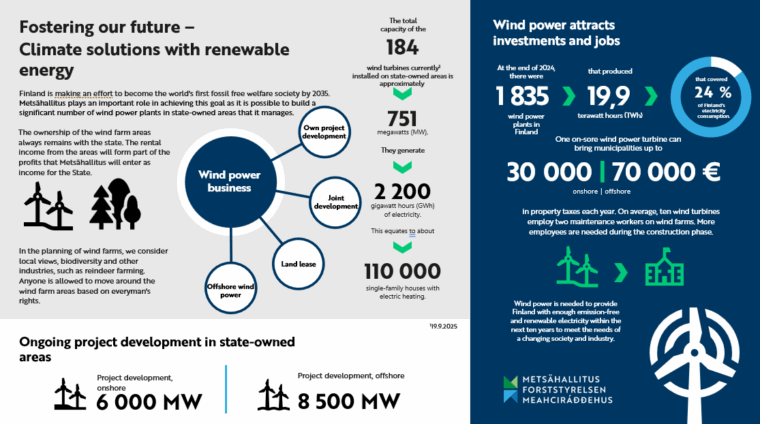Climate solutions and well-being through wind power
Finland strives to become world’s first fossil-free welfare society by 2035 – Metsähallitus plays an important role in achieving this goal as it is possible to build a significant number of wind power plants in state-owned areas that it manages. We are looking for a wind power developers and operators to realise these ambitious plans with us.
The state-owned land we manage currently (11/2025) accommodates 184 wind power stations, which together produce energy equivalent to the electricity consumption of around 110,000 electrically heated single-family houses.
In the coming years, dozens of new wind turbines will be built on state lands. On state-owned land, approximately 6,000 MW of onshore wind power and 8,500 MW of offshore wind power are under project development at the moment. Once these have been built, more than EUR 1 billion will have been invested in wind energy produced on state-owned land. In addition, the construction of these power stations has provided employment for thousands, and major positive impacts have been brought to regional economies.
Metsähallitus also has a certified environmental management system, ISO 14001, on the basis of which environmental goals are adopted annually.
We operate actively and responsibly in business for the benefit of the environment, society and people. In all our operations, we follow Metsähallitus’ Code of Conduct, which contains our key principles of responsible and ethical operations.
Metsähallitus plays a key role in wind power project development
The role of Metsähallitus is to develop wind power projects to the point where they are ready for construction. This means that we
- seek out areas suitable for wind power production
- carry out EIA and zoning processes
- prepare plans for placement of power stations
- design road and electricity connections
- apply for various required permits including building permits.
We also cover the expenses for these measures. After these stages are complete, we put the project out to tender and sell the project rights. Please note that at offshore our operating model differs from this – find details here.
We also have good aggregate reserves in many wind power areas and we are happy to negotiate their use in wind power projects.
Land or water never change ownership, but rather remains with the state and is rented out, providing some of Metsähallitus’s income paid to the state.
Planning involves cooperation
Wind power areas on state-owned land are typically quite far away from population centres. The common forms of land use in these areas include recreational uses such as hunting, berry picking and spending time in nature, and also reindeer husbandry in more northern regions. We discuss with landowners and establish the location of valuable areas, taking these into account as far as possible when locating power stations in the area.
In each area we identify key environmental values such as different protected areas, significant biotopes and conservation status of bird and plant species, to avoid any negative impact on these. We therefore aim to form the most comprehensive overview possible of the use of the area in question so that we can minimise the potential impacts of the wind power station on other activities. These discussions often also involve opportunities for cooperation, such as work to improve the road network so that it effectively serves as many as possible.
The measures described above are planned, implemented and reported in detail in the statutory environmental impact assessments (EIA) and during the planning process.
All forms of land use can continue as before in the wind power area. Mobility is unrestricted except on active construction sites during the construction stage. The area around the electric substations is fenced in for safety reasons.
The benefits of wind power are significant
Wind power is a profitable business that does not require subsidies. The electricity of many new wind parks is sold in advance to large electricity consumers through long-term sales contracts. For example, 60% of the electricity produced by the Piiparinmäki wind park built on state-owned land is sold to technology company Google.
In addition, the property tax paid by wind power stations is an important source of income for many municipalities. It can amount to tens of thousands of euros per year for each wind power station. Nowadays, the aim is normally to establish dozens of wind power stations in each wind park. On average, ten wind power stations provide employment for two maintenance workers. More employees are needed, of course, during the construction phase.
Many municipalities are also aiming to move towards carbon neutrality. Wind power stations located within a municipality significantly reduce its municipal emissions in the carbon balance calculations.
Usefull links
- Finland as a wind power market, businessfinland.fi
- Finland’s Integrated Energy and Climate Plan, julkaisut.valtioneuvost.fi
- Energy pages of the Ministry of Economic Affairs and Employment, tem.fi
- General information on wind power in Finland, suomentuulivoimayhdistys.fi
- Land use planning steers wind power construction, ymparisto.fi
- State of the power system in Finland, Finngrid.fi
Contact us

Otto Swanljung
Puh. +358405601715
Executive Assistant: Helena Pallari, tel. +358503960011
Markku Tuominen
Puh. +358407234895
